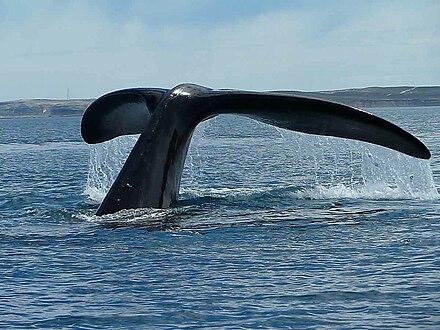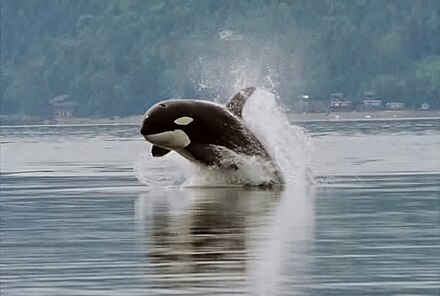Whale watching
Whale watching
Whale watching is the practice of observing whales and dolphins in their natural habitat, enjoyed by millions of people around the world every year. Whales are watched most commonly for recreation like bird watching but the activity can also serve scientific or educational purposes. Paid tour boats are common but often whales can be seen from shore or personal watercraft. Some practical ferry crossings pass through areas in which whales or icebergs may be spotted, but these normally do not announce whale sightings or deviate course to get a better look. Many regional whale watching groups exist that will share knowledge and sighting info with voyagers.
Stay safe
General boating safety can be found in cruising on small craft.
Conservation
See also: Animal ethics
The rapid growth of the number of whale-watching trips and the size of vessel used to watch whales may affect whale behaviour, migratory patterns and breeding cycles. There is now strong evidence that whale watching can significantly affect the biology and ecology of whales and dolphins.
Environmental campaigners, concerned by what they consider the "quick-buck" mentality of some boat owners, continue to strongly urge all whale watcher operators to contribute to local regulations governing whale watching (no international standard set of regulations exist because of the huge variety of species and populations). Common rules include:
- Minimize speed/"No wake" speed
- Avoid sudden turns
- Minimize noise
- Do not pursue, encircle or come in between whales
- Approach animals from angles where they will not be taken by surprise
- Consider cumulative impact - minimize number of boats at any one time/per day
- Do not coerce dolphins into bow-riding.
- Do not allow swimming with dolphins. (This last rule is more contentious and is often disregarded in, for example, the Caribbean.)
(Source: Whale and Dolphin Conservation Society, WDCS)
Almost all popular whale-watching regions now have such regulations. Campaigners hope that a combination of political pressure, free advertising and promotion by ethical tourism operators and boat operators' personal passion for marine wildlife compel them to adhere to such regulations.
One example of such regulations is the Be Whale Wise campaign of the Northeast Pacific.
Popular locations

Africa
South Africa
- Plettenberg Bay is a stunning beach town surrounded by mountains, forest and ocean. Boat trips and land-based viewing of whales, dolphins, and seals. Sightings include: Southern Right, Humpback, Brydes and occasionally Sei Whales and Orcas. Dolphins are also abundant which include Common Dolphins who love to swim alongside the ocean safari boats, and the playful Bottlenose and endangered Humpbacked dolphin.
- Hermanus is a place to spot southern whales even from the shore. The town has the world's only Whale Crier, who announces the sightings by blowing his horn. In September Hermanus is a venue of the Whale Festival.
- De Hoop Nature Reserve, and base of the Whale Trail, a 5-day hike along the coast with spectacular views of the whales during season.
- Cape Town - during the season many of the beaches and viewpoints provide whale watching opportunities.
Europe
Portugal
- Azores Islands - Year-round 4 resident species (including sperm whales), and from March up to 24 (a third) of all known cetacean species.
Norway
- Andenes in Vesterålen - Sperm whales are often seen here.
- Krøttøya near Harstad - whale watching both winter and summer
Iceland
Iceland is one of the best locations in Europe for whale watching (see this website). The most suitable time to see whales is from May to September.
- Húsavík - The Skjálfandi bay is great place to observe numerous kinds of whales. Minke whale and humpback whale are the most frequently spotted kinds, white-beaked dolphin and the harbor porpoise are also fairly common. Blue whale, fin whale, orca, northern bottlenose whale and sei whale are less frequent visitors to the bay.
- Reykjavík - Several operators offer whale watching tours in the Iceland capital area all year round.
- Snaefellsnes - best place to see orcas in Iceland
- Westfjords, Holmavik - Steingrimsfjordur fjord is an important feeding ground for humpback whales and ideal for whale watching
Spain
North America
Canada
- Churchill, Manitoba becomes the world's largest concentration of beluga whales each summer, between mid-June and mid-August. You can see them by boat, or even by snorkeling.
Atlantic
- The Gulf of St. Lawrence, starting at Tadoussac or Rivière-du-Loup and continuing eastward to Newfoundland (e.g. St. John's), is a common venue for short boat tours. Whales may also be spotted in the open Atlantic.
Pacific
- British Columbia - This province has a natural abundance of wildlife and there are many tour operators offering opportunities for guided trips, most of whom operate with a common sense and respect for the environment. Whale watching is popular off of the coast of Tofino where you are likely to see grey whales, humpback whales and sea lions. In addition to whales, grizzly bears and black bears may also be seen.
United States of America
Atlantic
- Cape Cod - Humpback whales are a common site in the Atlantic off of Massachusetts.
- Gloucester (Massachusetts) - Gloucester, Massachusetts is the whale watching capital of New England. For hundreds of years people have traveled to Gloucester to see Humpback Whales, Minke Whales, Blue Whales, Northern Right Whales, Sperm Whales, Pilot Whales and several other whale species whom migrate every year on the abundant natural resources off the coast of Gloucester, Massachusetts.
Pacific
-
Monterey Bay - Gray whales migrate from Alaska to Baja in the Spring and Fall. Blue whales, humpbacks, orcas and dolphins can be seen at other times of year.
-
Puget Sound offers exceptional viewing of not only migrating Gray and Orca whales but also several pods of Orcas are residence around the San Juan Islands.

Caribbean
- Dominican Republic - 160 km (100 miles) north of this island nation is the Silver Bank where the largest concentration of humpback whales anywhere in the world gather each Spring. Pricey live-aboard charters can be arranged, allowing the amazing opportunity of snorkeling with the whales. Elsewhere on the islands whales may be seen on more typical day trips.
Oceania
Australia
- Head of the Bight - near Great Australian Bight Marine Park in South Australia, a yearly destination for southern right whales.
- Port Ann - in the South West (Western Australia), a yearly destination for southern right whales.
- Anywhere by the coast in New South Wales and Southeast Queensland – whales migrate up north here from May-November. It can mostly be seen off the coast, although taking the boat out gives you better views
New Zealand
- Kaikoura - Depending on the season you may see migrating Humpback Whales, Pilot Whales, Blue Whales and Southern Right Whales, as well as Orca and the Hector's Dolphin (the world's smallest and rarest Dolphin).
Polynesia
- Vava'u - Whale-watching tours to observe humpback whales between June and November.